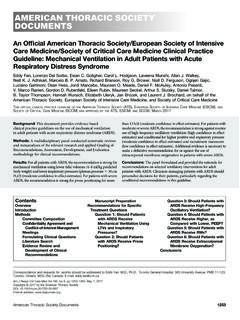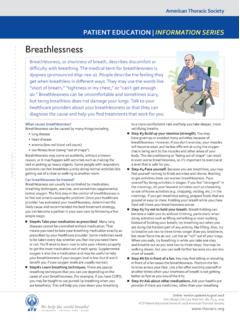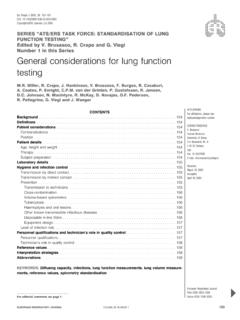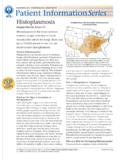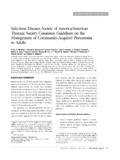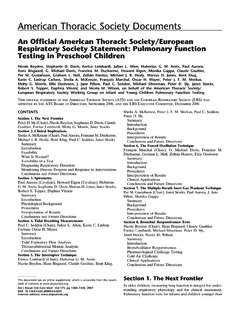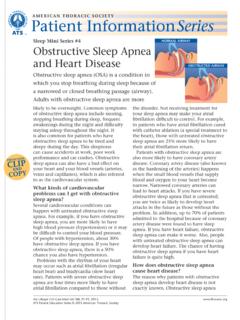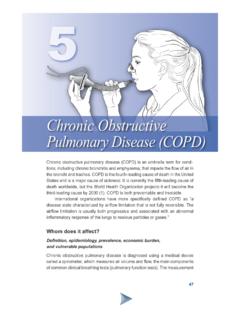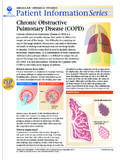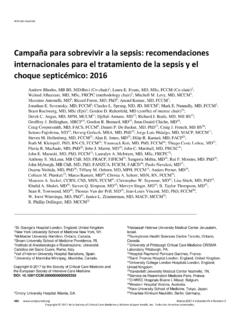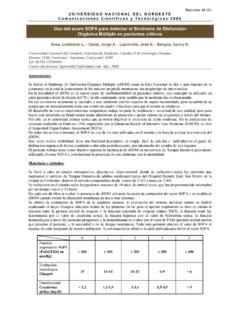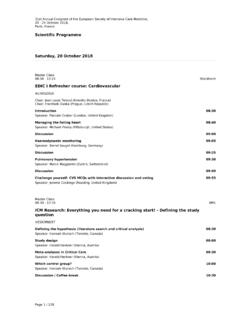Transcription of American Thoracic Society
1 American Thoracic Society Am J Respir Crit Care Med Vol 163. pp 283 291, 2001 Internet address: International Consensus Conferences in Intensive Care Medicine: Noninvasive Positive Pressure Ventilation in Acute Respiratory Failure O RGANIZED J OINTLY BY THE A MERICAN T HORACIC S OCIETY , THE E UROPEAN R ESPIRATORY S OCIETY , THE E UROPEAN S OCIETY OF I NTENSIVE C ARE M EDICINE , AND THE S OCI T DE R ANIMATION DE L ANGUE F RAN AISE , AND APPROVED BY THE ATS B OARD OF D IRECTORS , D ECEMBER 2000 Noninvasive positive pressure ventilation (NPPV) was appliedfirst to patients with chronic pulmonary disease but is now be-ing used to support those with acute respiratory failure (ARF).An International Consensus Conference in Intensive CareMedicine considering the role of NPPV in ARF was held inParis, France, from April 13 14, 2000; sponsored by the Criti-cal Care Assembly of the American Thoracic Society (ATS),the European Respiratory Society (ERS), the European Soci-ety of Intensive Care Medicine (ESICM), and the Soci t deR animation de Langue Fran aise (SRLF).
2 The methods of the Consensus were established by the Na-tional Institutes of Health (1) and adapted subsequently foruse in critical care medicine (2). Briefly, the process com-prised four phases. First, five key questions were formulatedby the scientific advisors designed to address issues integral tothe evaluation of noninvasive ventilatory support in its currentand future roles. Second, a comprehensive literature searchwas performed and key articles precirculated to a jury of 10clinician scientists who were not experts in the field under dis-cussion. Third, authorities in NPPV selected by the Organiz-ing Committee and scientific advisors delivered focused pre-sentations during a two-day symposium attended by the juryand about 150 delegates. Each presentation was followed bydebate and discussion. Finally, the jury summarized the avail-able evidence in response to the questions over the two daysimmediately after the the purposes of this report, NPPV was defined as anyform of ventilatory support applied without the use of an en-dotracheal tube, and was considered to include continuousc positive airway pressure (CPAP), with or without inspiratorypressure support; volume- and pressure-cycled systems, pro-portional assist ventilation (PAV), and adjuncts such as theuse of helium oxygen (heliox) gas mixtures.
3 The term acuterespiratory failure (ARF) was considered to include patientswith acute lung injury (ALI) and acute respiratory distresssyndrome (ARDS), those with acute exacerbations of obstruc-tive airflow limitation ( , asthma and COPD); acutely dec-ompensated patients with the obesity hypoventilation syn-drome (OHS) and cardiogenic pulmonary edema (CPE);patients developing ARF in the perioperative period; andthose with either difficulty weaning from invasive mechanicalventilatory support, or in whom endotracheal intubation (ETI)was considered inappropriate. The information presented tothe jury was designed to address the following five questions. QUESTION 1: WHAT ARE THE RATIONALE, POTENTIAL BENEFITS, AND GOALS FOR NPPV? Patients require ventilatory assistance to reduce the Pa CO2 (Fig-ure 1) and/or to improve oxygenation (Figure 2). If they canreceive appropriate noninvasive ventilatory assistance, pa-tients are spared the discomfort and risks associated with en-dotracheal intubation (ETI).
4 Although studies suggest thatNPPV is associated with a reduced incidence of nosocomialpneumonia, methodological problems mandate reinvestiga-tion of this issue. Potential benefits must be balanced againstthe discomfort of a nasal or facial mask and risks specific toNPPV ( , failure to provide sufficient oxygenation or CO 2 elimination, eye or nasal trauma, gastric distension/aspiration).The goals of NPPV differ depending upon the clinical con-text. During acute decompensations of asthma or COPD, thegoal is to reduce CO 2 by unloading the respiratory musclesand augmenting alveolar ventilation, thereby stabilizing arte-rial pH until the underlying problem can be reversed. Whenemployed during episodes of hypoxemic ARF the goal is toensure an adequate Pa O2 until the underlying problem can bereversed. When applied continuously to patients with chronicventilatory failure the goal of NIPPV is to provide sufficientoxygenation and/or CO 2 elimination to sustain life by revers-ing atelectasis or resting the respiratory muscles.
5 When ap-plied intermittently to patients with OHS, the goal is to limitsleep- and position-induced adverse changes in oxygenationand CO 2 elimination and their pathophysiological sequelae bystenting the upper airway, increasing lung volume, and aug-menting alveolar ventilation. In cardiogenic pulmonary edema,the goal of NPPV is to improve oxygenation, reduce work ofbreathing, and increase cardiac output. Jury and coauthors : Timothy W. Evans (London, UK, Chairman ), Richard K. Albert(Denver, CO), Derek C. Angus (Pittsburgh, PA), Julian F. Bion (Birmingham, UK),Jean-Daniel Chiche (Paris, France), Scott K. Epstein (Boston, MA), Jean YvesFagon (Paris, France), Marco Ranieri (Pisa, Italy), Jacob Iasha Sznajder (Chicago,IL), Antoni Torres (Barcelona, Spain), Keith R. Walley (Vancouver, BC, Canada). Consensus Conference Organization : Scientific Advisors: Nicholas Hill (Providence,RI), Laurent Brochard (Paris, France).
6 International Consensus Conference Committee : ATS: Arthur Slutsky (Toronto, ON,Canada), Catherine Sassoon (Long Beach, CA); ERS: Antoni Torres (Barcelona,Spain); ESICM: Francois Lemaire (Creteil, France), Graham Ramsay (Maastrict,Netherlands); SRLF: Jordi Mancebo (Barcelona, Spain), Christian Richard (Paris,France).The conference was funded in part by an unrestricted educational grant fromRespironics, article is copublished and copyrighted by American Journal of Respiratory andCritical Care Medicine , Intensive Care Medicine , and R animation . 284 American JOURNAL OF RESPIRATORY AND CRITICAL CARE MEDICINE VOL 163 2001 Determining whether NPPV Is a Valuable Approachin Clinical Practice The clinical and physiologic rationales for NPPV suggest it mayhave advantageous ( , avoidance of ETI), and/or disadvanta-geous ( , failure to provide adequate gas exchange) , NPPV may decrease ( , reduced requirement forICU) or increase ( , costs of staff training/education and pa-tient contact time) resource utilization.
7 These potentially com-peting effects will determine whether NPPV is a valuable pro-cedure and mandate careful assessment of the epidemiology ofpotential target populations, the effects on patient outcomesand costs, and the rigor with which studies were conducted. Epidemiology and Potential Target Populations for NPPV Most clinical data are derived from interventional trials, whichoften did not keep comprehensive logs of excluded of nontrial data have detailed the number of candi-dates for NPPV (numerator) without recording the total num-ber of cases (denominator). However, a single-center study inthe United Kingdom suggested up to 20% of hospitalized pa-tients with chronic obstructive pulmonary disease (COPD)may be candidates for NPPV (3). Second, a survey of NPPVuse in 42 medical intensive care units (ICUs) in France, Swit-zerland, and Spain demonstrated NPPV was used prior to me-chanical ventilation in 16% of cases (range, 0 67%) (4).
8 Last,a survey of hospitals in the United Kingdom found that 52%do not have the capability to provide NPPV and 68% of thosewho do use NPPV to treat fewer than 20 patients per year (5).There are no data from surgical ICUs and almost no informa-tion on non-COPD patients. Patient-centered Outcomes and Costs Patient-centered outcome trials have principally addressed ratesof ETI, pneumonia, length of ICU or hospital stay, and mor-tality; together with patient comfort, compliance, and/or toler-ance. Criteria for ETI have varied and included subjective de-cision making as well as that made by physicians not directlyinvolved in the trial. Criteria for the diagnosis of ventilator-as-sociated pneumonia or hospital discharge have been subopti-mal or unspecified; and tolerance and comfort not objectivelydefined. To determine economic value , costs should be as-sessed to determine if NPPV is cost-effective (after effective-ness is determined) or less expensive (after equivalence hasbeen demonstrated) (6).
9 One cost-effectiveness study from theUnited Kingdom has demonstrated NPPV for COPD patientsto have decreased costs and mortality compared with standardward care, although the control arm had a high mortality (7).Studies of NPPV costs have highlighted the need to considernumerous costs, including those associated with personnel andFigure PaCO2 is increased, and minute ventilation is normal orincreased, the respiratory muscles are failing to generate sufficient alveo-lar ventilation to eliminate the CO2 being produced. Means of correctingthis pathophysiology include increasing alveolar ventilation by increasingtidal volume and/or respiratory rate, and reducing CO2 production CO2)by decreasing the work of breathing. Respiratory muscle failure can occurwhen the work of breathing is normal ( , numerous acute or chronicneuromuscular problems), or increased ( , patients with COPD, asthma,or the obesity hypoventilation syndrome), and presumably because of in-adequate delivery of oxygen to the respiratory muscles ( , approxi-mately one-third of patients presenting with cardiogenic pulmonaryedema).
10 When PaCO2 is increased and minute ventilation is low the levelof consciousness is generally impaired. Such patients usually require intu-bation for airway protection in addition to ventilatory assistance, unlessthe hyperapnia can be reversed within Figure develops as a result of alveolar hypoventilation(which is accompanied by increases in PaCO2 and is addressed in Figure1) and from perfusion going to areas where the ratio of alveolar venti-lation (A) to perfusion ( ) is , ( , low or, in the extreme,shunt, where perfusion is going to areas of no ventilation). Hypoxemiais treated by augmenting the FIO2 (the lower the , the less the ef-fect), and by recruiting airspaces. Airspace derecruitment occurs whenthe transpulmonary pressure falls below the airspace collapsing orclosing pressure (as occurs in numerous conditions that alter surfactantor that decrease the lung or the chest wall compliance), and when thetranspulmonary pressure applied during inhalation fails to exceed air-space opening pressure.
